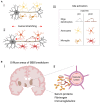The Immune System's Role in the Consequences of Mild Traumatic Brain Injury (Concussion)
- PMID: 33679762
- PMCID: PMC7928307
- DOI: 10.3389/fimmu.2021.620698
The Immune System's Role in the Consequences of Mild Traumatic Brain Injury (Concussion)
Abstract
Mild traumatic brain injury (mild TBI), often referred to as concussion, is the most common form of TBI and affects millions of people each year. A history of mild TBI increases the risk of developing emotional and neurocognitive disorders later in life that can impact on day to day living. These include anxiety and depression, as well as neurodegenerative conditions such as chronic traumatic encephalopathy (CTE) and Alzheimer's disease (AD). Actions of brain resident or peripherally recruited immune cells are proposed to be key regulators across these diseases and mood disorders. Here, we will assess the impact of mild TBI on brain and patient health, and evaluate the recent evidence for immune cell involvement in its pathogenesis.
Keywords: concussion; inflammation; microglia; mild TBI; neurodegenenerative diseases; neuroimmunology.
Copyright © 2021 Verboon, Patel and Greenhalgh.
Conflict of interest statement
The authors declare that the research was conducted in the absence of any commercial or financial relationships that could be construed as a potential conflict of interest.
Figures


Similar articles
-
Traumatic brain injury (TBI) in collision sports: Possible mechanisms of transformation into chronic traumatic encephalopathy (CTE).Metabolism. 2019 Nov;100S:153943. doi: 10.1016/j.metabol.2019.07.007. Metabolism. 2019. PMID: 31610856 Review.
-
[Late-onset Neurodegenerative Diseases Following Traumatic Brain Injury: Chronic Traumatic Encephalopathy (CTE) and Alzheimer's Disease Secondary to TBI (AD-TBI)].Brain Nerve. 2016 Jul;68(7):849-57. doi: 10.11477/mf.1416200517. Brain Nerve. 2016. PMID: 27395469 Japanese.
-
Clinical correlates to assist with chronic traumatic encephalopathy diagnosis: Insights from a novel rodent repeat concussion model.J Trauma Acute Care Surg. 2017 Jun;82(6):1039-1048. doi: 10.1097/TA.0000000000001443. J Trauma Acute Care Surg. 2017. PMID: 28520686
-
[Mild traumatic brain injury and postconcussive syndrome: a re-emergent questioning].Encephale. 2012 Sep;38(4):329-35. doi: 10.1016/j.encep.2011.07.003. Epub 2011 Aug 31. Encephale. 2012. PMID: 22980474 Review. French.
-
The Role of Microglia in the Etiology and Evolution of Chronic Traumatic Encephalopathy.Shock. 2017 Sep;48(3):276-283. doi: 10.1097/SHK.0000000000000859. Shock. 2017. PMID: 28234788 Free PMC article. Review.
Cited by
-
Modulation of microglia activation by the ascorbic acid transporter SVCT2.Brain Behav Immun. 2024 Aug;120:557-570. doi: 10.1016/j.bbi.2024.07.003. Epub 2024 Jul 6. Brain Behav Immun. 2024. PMID: 38972487 Free PMC article.
-
Nutritional interventions to support acute mTBI recovery.Front Nutr. 2022 Oct 14;9:977728. doi: 10.3389/fnut.2022.977728. eCollection 2022. Front Nutr. 2022. PMID: 36313085 Free PMC article.
-
Traumatic brain injury: Bridging pathophysiological insights and precision treatment strategies.Neural Regen Res. 2026 Mar 1;21(3):887-907. doi: 10.4103/NRR.NRR-D-24-01398. Epub 2025 Mar 25. Neural Regen Res. 2026. PMID: 40145994 Free PMC article.
-
Profiling the neuroimmune cascade in 3xTg-AD mice exposed to successive mild traumatic brain injuries.J Neuroinflammation. 2024 Jun 13;21(1):156. doi: 10.1186/s12974-024-03128-1. J Neuroinflammation. 2024. PMID: 38872143 Free PMC article.
-
Nutritional Considerations of Irish Performance Dietitians and Nutritionists in Concussion Injury Management.Nutrients. 2024 Feb 9;16(4):497. doi: 10.3390/nu16040497. Nutrients. 2024. PMID: 38398823 Free PMC article.
References
-
- Spira JL, Lathan CE, Bleiberg J, Tsao JW. The impact of multiple concussions on emotional distress, post-concussive symptoms, and neurocognitive functioning in active duty United States marines independent of combat exposure or emotional distress. J Neurotrauma. (2014) 31:1823–34. 10.1089/neu.2014.3363 - DOI - PMC - PubMed
Publication types
MeSH terms
LinkOut - more resources
Full Text Sources
Other Literature Sources
Medical

